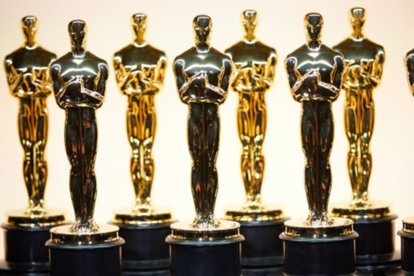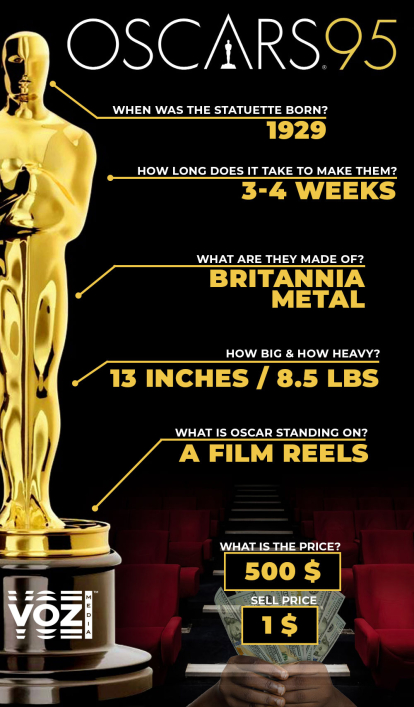Faye Dunaway's big mistake and other Oscars anecdotes
The statuette awarded each year by the Academy of Motion Picture Arts and Sciences turns 95. It has stood the test of time.

(Premio de la Academia de Artes y Ciencias Cinematográficas)
The most important ceremony in the film industry is just around the corner: the Oscars. The awards ceremony, organized by the Academy of Motion Picture Arts and Sciences, will celebrate its 95th edition. The Oscar has always been a big part of the event. This award is given year after year to a select group of artists that the Academy decides to reward for their cinematographic achievements. At 13.5 inches tall and weighing 8.5 pounds, the Oscar is the highest award that any film industry worker is eligible for.
What few people know is that the Oscars is not the official name. It's not even close. The official name of the award is the Academy Award® of Merit and no one knows for sure how the statuette came to be called the Oscar.
Where does the name 'Oscar' for the award come from?
There are many theories about it, but no certainty about the origin of this denomination. Perhaps the most widespread, explains The Universe, is that of the librarian and later executive director of the Academy, Margaret Herrick. She said the statuette resembled her uncle Oscar and affectionately began calling it that. Another theory is explained in EW magazine. This version claims that actress Bette Davies named the award. She claimed that the unofficial name of the award was in honor of her first husband, musician Harmon Oscar Nelson Jr.
Although the origin of the name Oscar Award is not clear, we do know who was the first person to use the name and when. According to the Academy, in 1934, Hollywood columnist Sidney Skolsky was the first person to publicly adopt the name. He did so in an article discussing the first Best Actress winner, Katharine Hepburn. However, it took the Academy another five years and it was not until 1939 that they officially coined the name Oscar to refer to their award.
The design has stood the test of time
The award was first presented in 1929, during the first American film ceremony. On May 6, 1929, the Academy presented the first statuette in the Blossom Room of the Roosevelt Hotel in Hollywood. Since then, the Academy explains, more than 3,000 statuettes have been awarded.
However, the first sketch dates from two years earlier, in 1927. In November of that year, MGM art director Cedric Gibbons presented the first design for the statuette. He did so by releasing the first draft of the award in the Academy's magazine. The sketch showed a knight wielding a sword, standing in front of a reel of film. That reel was composed of five spokes, each representing one of the five original branches of the Academy (actors, directors, producers, technicians, and writers). The sword wielded by the knight, the designer explained, was a symbol of protection for the welfare and advancement of the industry.
A year later, in 1928, Gibbons decided that sculptor George Stanley would make the first physical statuette. According to the Academy, together they worked out the final design in which the figure of the knight is outlined and introduced the only change: the reel of film, instead of being in front of him, was placed at his feet.
Britannia, the metal used to make the Oscars
The design was so convincing to the Academy that it has never undergone any significant changes. Only the size of the base was modified in 1945. Since then, new statuettes are made every year, which are hand-cast in an alloy known as Britannia. After this, Epner Technology bathes each statuette in 24-karat gold.
At first, it was made of bronze, but after a few years, it was changed to Britannia. There was one exception: during World War II, due to the scarcity of metals. The Academy explains that the awards were made of plaster during the three years of the war. Once finished, all these figures were replaced by 24-carat gold-plated Britannia metal figures.
The award can only be sold for $1
The company in charge of making each award is RS Owens & Company, in Chicago, and they start making them a year before the awards ceremony takes place. Each statuette requires the work of 12 people for at least 20 hours and costs $500.
However, if any awardee, or their heirs, wishes to sell their statuette, they may only ask $1 for it and, in addition, must offer it to the Academy first. According to Noticias de Salamanca, the policy was implemented in 1950, after the Academy discovered that many of its awards were being auctioned off.

infografia-oscars-ing
Oscars records
Speaking of award winners, Katharine Hepburn is the actress who has won the most Oscars, proudly accepting four statuettes. However, she is not the performer with the most nominations. That record belongs to Meryl Streep, who has been nominated 21 times and won three times. According to El Universo, Clint Eastwood holds the record for the most Oscars (4), while Jack Nicholson is the actor with the most nominations (12).
Some films stand out in terms of the number of awards. Ben-Hur and Titanic each won eleven awards and held the record. That was until 2003. El Universo reported that The Lord of the Rings: The Return of the King received 17 nominations and, against all odds, won every single one of them. In addition to the 17 for this film, seven more statuettes would need to be added to tie Walt Disney. Disney holds the record for most Oscars, winning 22 awards and three honorary awards out of 59 nominations during his lifetime.
Spare Oscars
Back to the award itself, few people know that 50 new statuettes are made each year. This does not mean that they all get handed out, but those that are left over are kept in a vault at the Academy until the following year. This decision was made after what happened at the 2000 awards ceremony.
That year, according to The Hollywood Reporter, many statuettes were stolen weeks before the ceremony. Since then, the Academy orders 50 new statuettes every year and all the remaining ones are stored in a protected vault to be used in case it is necessary.
Why is the winner's envelope opened in the middle of the awards ceremony?
Another crime is also behind the tradition of opening the envelope live. El Universo explains that this became a custom after a leak in 1940. That year, The LA Times broke the Academy's rules and released all the Oscar winners before the ceremony took place. For this reason, the following year, in 1941, it was decided that the envelope be opened in the middle of the award ceremony to reveal the winners.
No one can forget what happened during the awards ceremony in 2017. BBC recalled that Faye Dunaway announced La, La, Land as the winner of Best Picture and, minutes later, Jordan Horowitz, the film's producer, had to announce that there had been a mistake and revealed that Moonlight was the real winner in that category. This will surely not happen this year at the 95th edition but makes for a great anecdote in Oscars history.
RECOMMENDATION





















